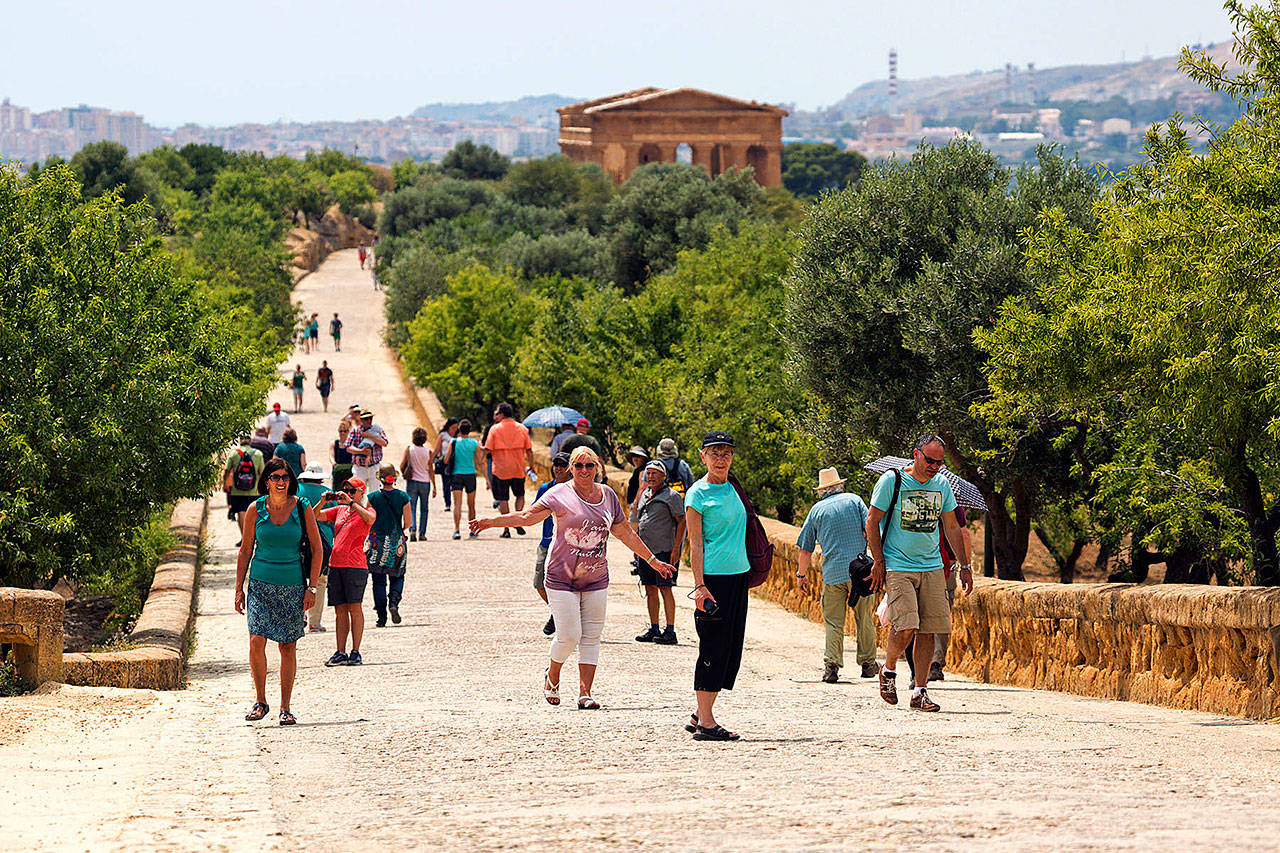The Italian island of Sicily is — perhaps more than any corner of Europe — a layer cake of civilizations. On one island, visitors can marvel at a well-preserved Greek temple, admire the glittering mosaics of a Norman cathedral, wander through Carthaginian ruins, and feast at a market that evokes an Arabian souk.
One of my favorite places to experience Sicily’s rich stew of history and cultures is at the Norman cathedral of Monreale, just southwest of the capital, Palermo. Like the tide ebbs and flows, so does the point where Islam and Christianity meet. That comes with tension, which was sorted out as elegantly a thousand years ago as similar frictions are today. When the Catholic Normans took Sicily from the Muslim Arabs, they planted their sword firmly by tearing down mosques and building bold churches that stood like fortresses, proclaiming, “This is now Christian again.”
Built between 1174 and 1189, Monreale Cathedral is an amalgamation of Byzantine, Norman, and Arab elements in a Romanesque building. Its highlight is the twinkling interior, slathered with gold-leaf mosaic Bible stories. The cathedral is supported by about a dozen ancient pillars — shipped from Rome by Pope Lucius III, who wanted to cement the Vatican’s relationship with Sicily’s new Norman overlords with an appropriate gift.
Long before the Normans, parts of Sicily were colonized by the Carthaginians — successors of the seafaring Phoenicians, and great foes of the Sicilian Greeks and the Romans. Few travelers are aware of the impact of Carthage in Europe (in part because losers don’t get to write history). A visit to the island of Mozia, off Sicily’s west coast, provides a glimpse at what a powerful force they’d been.
The Carthaginians came from modern-day Tunisia (in northern Africa), a major trading center of the Mediterranean. Around 800 BC, they established a trade outpost on Mozia — just a day’s sail away from their home. A town with defensive walls and a port prospered on the island for centuries.
These days, travelers can reach Mozia via a pleasant boat ride through salt flats and across a lagoon. The island’s ancient ruins include bits of mosaics from a wealthy home and the remains of a pool — likely used for sacred bathing and religious rituals. A small museum contains artifacts found on the island and surrounding area.
Around the time the Carthaginians came to Sicily, Greeks, who were experiencing a population boom, also began to settle here. Colonists flooded the island’s shores, settling primarily in the east (closer to Greece) and on the southern coast (with its good trade routes).
The best Greek sight in Sicily is the Valley of the Temples, on the southwest coast near the town of Agrigento. In the fifth century BC, Agrigento was the third largest city in the Greek world. Sicilian-Greeks displayed their prowess by building 15 grand temples in under 80 years, rivaling the great temples of Greece itself.
Today the temples survive in various states — some partially rebuilt, others in poetic ruins, and one — the Temple of Concordia — in pristine condition. The Temple of Olympian Zeus — built to thank the gods for their victory against the Carthaginians — was the largest Doric temple in the ancient world (longer than a football field and taller than a 10-story building). Between the columns holding up the roof were telamons — stone giants. Now, scant remains of three of these figures are scattered at the site, melting into the earth like dissolving sugar cubes (a near-complete telamon is in the valley’s archaeological museum).
Unlike Agrigento, Palermo flourished much later, when Arabs arrived in AD 827 and made it the island’s capital. Arabs ruled Sicily for more than 200 years and had a profound influence here. They brought in new crops: citrus, nuts, sugar, dates, and cotton. They excelled at water engineering, turning dry areas into farmland and enlarging the city by channeling two rivers underground. Palermo became one of the largest and most modern cities in Europe.
In the 11th century, when Normans conquered and re-Christianized Sicily, they were so impressed with its culture that they let the existing Arab community stay, and called on their skills and know-how when building the new kingdom. Today, Arabian influence can still be found throughout the city. The architecture of Palermo Cathedral, the Norman Palace, and other buildings incorporate Arab decoration and engineering.
Palermo’s street markets also have an Arabian vibe, with stands selling North African- and Middle Eastern-influenced food, and vendors calling out to passersby in a traditional singsong way. The Arabs popularized fried foods, which is why so many Sicilian street food classics are served this way, including its famous deep-fried rice balls, called arancine.
For me, Sicily is a land of eurekas. No matter how many times I visit, I always find surprising charms and fascinating layers waiting to be discovered.
Rick Steves (www.ricksteves.com) writes European travel guidebooks and hosts travel shows on public television and public radio. Email him at rick@ricksteves.com and follow his blog on Facebook.
Talk to us
> Give us your news tips.
> Send us a letter to the editor.
> More Herald contact information.

























